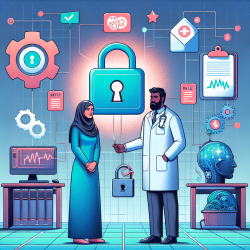Introduction
In the realm of speech-language pathology, the importance of maintaining data privacy cannot be overstated. As practitioners, we often rely on electronic health records (EHRs) to track progress and tailor therapy plans. However, the presence of Protected Health Information (PHI) in these records poses significant privacy challenges. A recent study titled Evaluating current automatic de-identification methods with Veteran’s health administration clinical documents sheds light on the effectiveness of various de-identification methods, offering valuable insights for practitioners.
Understanding De-Identification Methods
The study evaluates both rule-based and machine learning-based de-identification systems. Rule-based systems use pattern matching and regular expressions, while machine learning systems rely on algorithms trained on annotated data. Each method has its strengths and weaknesses, and understanding these can help practitioners make informed decisions about data handling.
Key Findings
- Rule-Based Systems: These systems excel in recognizing structured data like Social Security Numbers and Zip codes. However, they struggle with unstructured data and require manual rule updates, which can be labor-intensive.
- Machine Learning Systems: These systems offer higher precision and adaptability, especially when trained on specific datasets. They are more effective in handling unstructured data but require significant annotated training data.
Implications for Speech-Language Pathologists
For practitioners in speech-language pathology, the choice between rule-based and machine learning systems should be guided by the specific needs of their practice. If your work involves a high volume of structured data, rule-based systems may suffice. However, for practices dealing with diverse and unstructured data, investing in machine learning systems could enhance data privacy without compromising on the richness of the information.
Encouraging Further Research
The study highlights the need for customized de-identification solutions tailored to specific clinical environments. As a practitioner, you can contribute to this evolving field by participating in research or collaborating with data scientists to develop systems that meet the unique needs of speech-language pathology.
Conclusion
Understanding and implementing effective de-identification methods is crucial for safeguarding patient privacy while maximizing the utility of clinical data. By staying informed about the latest research and technologies, speech-language pathologists can enhance their practice and contribute to the broader goal of secure and effective healthcare delivery.
To read the original research paper, please follow this link: Evaluating current automatic de-identification methods with Veteran’s health administration clinical documents.










